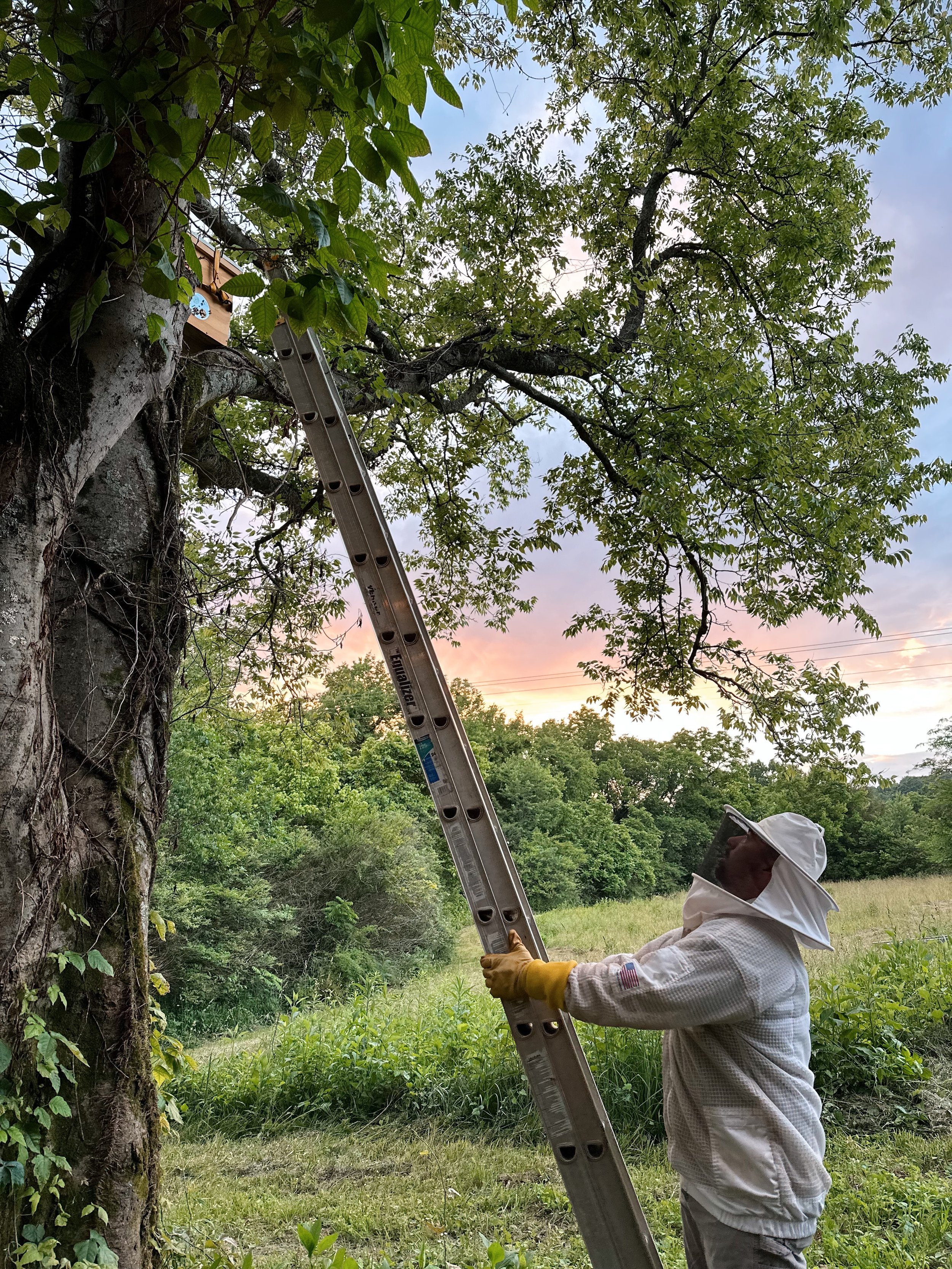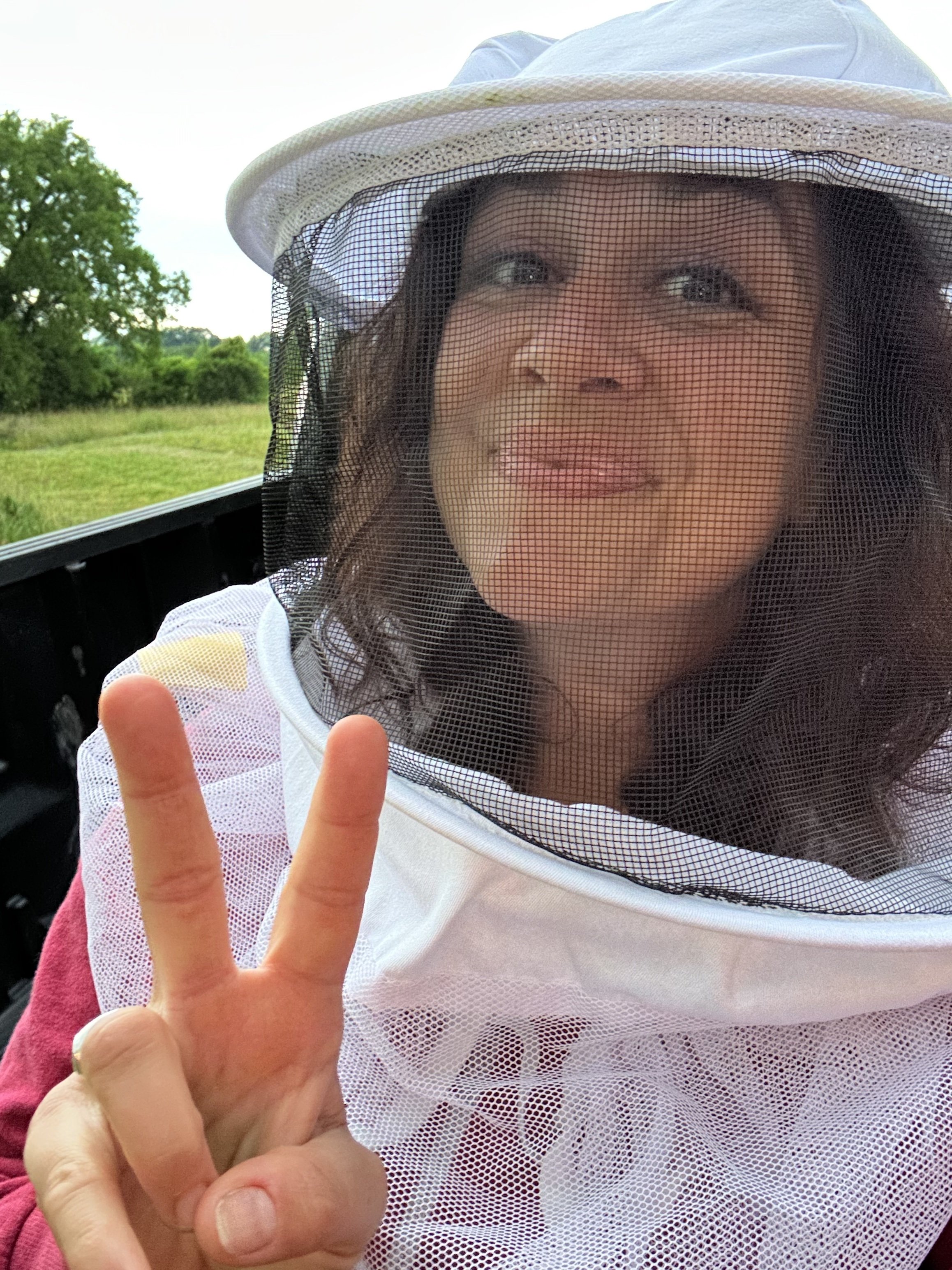A Beemergency! 🐝 Catching & Transferring a Honeybee Swarm
I recently shared that I went to Beekeeping Bootcamp this past spring and was learning how to expand our hives naturally by catching wild bee swarms here on Kindred Farm. This spring, we purchased 3 horizontal hive traps from Adam and Leslie at Bee Kept and set them up high in some trees on the farm and hoped we would catch some swarms!
And….nothing. For so long, nothing. We’ve had a really weird spring here this year, and everything was happening later than usual. Still, we checked the traps almost every day for some action and were starting to accept that we might not catch a swarm this spring.
THEN! Finally, a little over a week ago, we found several bees coming and going at one of our traps! A few bees at first became several, and it was clear they had chosen the trap to move into! 🙌🏽
So far so good until, two days ago, when we were alarmed to see that the bees were “bearding” all over the front of the swarm trap. Bearding can happen when it’s really hot and humid, and a large amount of bees congregate outside the hive to help regulate the temperate inside the hive. But it can also mean that the hive is overcrowded, which was alarming and also amazing considering they had only been there a week!
After consulting over the phone with Adam at Bee Kept (one of the benefits of being in the BK Bee Club!), he looked closely at the video we sent him and advised us to take action quickly so the Queen didn’t suddenly decide to PEACE OUT ✌🏽 on our hive and go look for a better home elsewhere.
Here’s how the bearding looked on the hive trap up in the tree…
We had a definite beemergency on our hands.
The trap only has 6 frames, so it’s only meant to be a temporary home, not their “forever home hive” which is a horizontal hive where they live permanently. Option 1 was to put their forever home hive at the base of that same tree and move them into it the next day. However, that tree is not a good location for a hive because it’s way too close to high traffic areas on our farm. We wanted their forever home to be under a different tree across the pasture. The challenge is that bees can only be moved 3 feet a day, or else it will mess up their internal “GPS” and they will no longer know where they are. If you’re going to move bees from the location they’ve chosen as “home” you have to move them only 3 feet a day until you get them to the location you want them to say, OR you have to move them 3 miles away to reset their GPS, and then after 3 weeks, move them back to the new location where you want them to stay.
(It’s all threes…hmm…)
We chose option 2: to move this swarm in the trap to a friend’s land that’s over 3 miles away and then transfer them to their forever home hive while there. Then after 3 weeks, we would move them back to our land to the right spot.
In order to do that, we had to coax the bees back into the trap using the smoker, close the entrance for the night, and then be ready to move them in the morning.
So, we had to get up on a high ladder in the dark, and by “we,” I mean Steven. As you can see, he was dressed in “beekeeper” on top and “lounge casual” on the bottom, which we don’t exactly recommend. 😬 Thankfully he only got stung once on his leg! As I held the ladder and cheered him on, he was finally able to get them in and close it up after 30-45 minutes up there.
The saga continues…
Early the next morning, when we went to move the bees in the trap to our friend’s land, we had a problem. There were a ton of bees on the front of the closed trap, wanting to get in…meaning we actually didn’t get all the bees inside the night before! Oops. They must have been in the tree or underneath or who knows where. But we just couldn’t leave that many out, so we decided to open up the door and let them all out and START OVER AGAIN. 😅
That evening, it rained a bit, which was actually great to calm the bees down, and it was much easier smoking them back into the trap on the second night. And this time, Steven wore appropriate gear. 😉
We immediately transferred them that night to our friend’s land more than 3 miles away, where their forever home hive was already waiting. We placed the trap on top of the hive to let them get acclimated for a few hours, and I went back in the afternoon to move them into the hive. Shout-out to our friend Russell for helping me with this! This was my very first swarm transfer, and I’m STILL giddy about it!
The very first photo at the top of this post is what it looked like when I arrived to do the transfer - they were bearding ALL OVER the front of the trap.
I was waiting on pins and needles to see what these incredible bees had done inside the trap. When we opened it up, we found that they had already build honeycomb on all 6 frames! There was also capped honey and tons of brood (eggs and larvae), which shows that there is a healthy and active Queen!
Once we moved them, we left them alone to get used to their new surroundings, and by evening, they were all going into their new forever home hive as planned! GOOD JOB, BEES! 👏🏼
In about 3 weeks, we’ll move the forever home hive back to our farm in the spot where it will stay permanently.
SO excited and grateful to have a strong, healthy bee colony on the farm this year and hopefully some delicious honey in the fall!
Bees are truly miraculous. 💛








